





Another rewarding pond season is coming to a close and it is time to ready the pond for winter.
If you live in an area that gets freezing temperatures in the fall and winter, then you will need to winterize your pond. It is a fall ritual for pond owners that is bittersweet. As you clean up and ready the pond for winter, you can lament about a great growing season, the relaxation your pond provided you, and look forward to another season of rewards. Winterizing the pond also gives you an excellent opportunity to check the state of your liner, your fish and your pump that you don't get as easily at other times of the year. Different people will winterize their pond in various ways, but there are a few things that you have to do to maintain healthy fish and plants for the future. If you so desire you can use products to help winterize the pond and your fish such as Microbe Lift Autumn/Winter Prep but it is not required. It is also advisable to get a pair of elbow length gloves, because the water will surely be cold enough to sting during fall cleanup.
Bottom cleaning
You'll want to make sure to clean out all debris, leaves and muck from the bottom of your pond. The cleaner you can get the pond before freezing weather comes, the healthier the quality of your water will remain through winter. You can purchase a pond vacuum if you have a large area to clean. You can also use a non-mechanical hand vacuum, which will work well for smaller ponds. If you don't want to purchase anything, you can use a fish net to dredge the bottom of the pond. You have to make sure to pull out all decomposable matter such as fallen leaves and the inevitable muck.
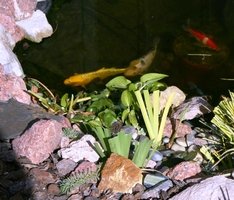
Plants
You need to winterize your pond plants prior to or just after the first freeze. Keep in mind that the longer you wait, the colder and more unbearable the water will be. You need to remove all annual surface plants such as water lettuce, parrots feather, and water hyacinth. These plants are extremely difficult to overwinter indoors, if not impossible, so your best bet is to compost them and start with new plants next year. You don't want to leave any of these plants on the surface because once they freeze, they will begin to decompose and contaminate your water. For tropical plants such as elephant ears and cannas, you will need to remove their tubers, clean them, remove foliage and store them in peat moss for the winter. Some tender perennials such as umbrella plant can be kept as well-watered houseplants for the winter.
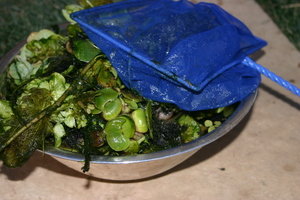 Surface plants skimmed out and headed to the compost
Surface plants skimmed out and headed to the compost
You also need to prepare your perennial pond plants such as rush, water lilies and irises. For potted bog plants and others that inhabit the upper levels of water, you need to cut them down to about one to three inches above the root zone and drop them deeper into the pond so that their crowns will not freeze. Make sure you remove any stowaways like string algae from the pot and stems.
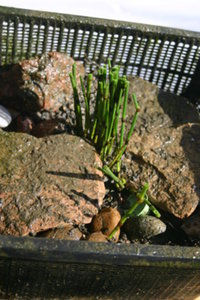
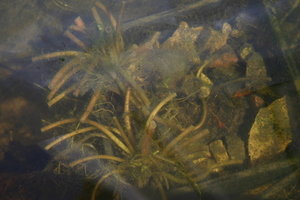 Trimmed back Zebra Rush Trimmed and lowered waterlily
Trimmed back Zebra Rush Trimmed and lowered waterlily
Waterlilies need to be lifted and trimmed as well. Cut all the leaves back to about an inch above the root zone. You can lower the lilies to a lower part of the pond if there is room. Make sure that if you have fish, you save room for them to overwinter in the deepest part of the pond.
Fish
If you keep fish in your pond such as koi and goldfish, they can survive through the winter in the pond so long as you take a few steps. A whole article could be written just on the subject of overwintering fish outdoors but for the purposes of this article, we'll just have a brief overview. There is an endless amount of information on the subject online if you want to read further.
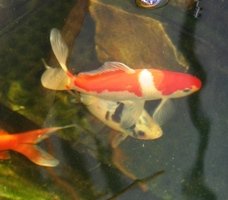
Take the opportunity during fall cleanup to check the health of your fish. Check for ulcers and strange or new coloration. If a fish's immune system is compromised prior to winter, their chances of surviving might be lowered. If you see any strange signs from your fish, take this opportunity to contact a local fish expert or vendor to address the problem.
Different people will recommend different courses of action, but in general you want to stop feeding your fish when the water temperatures fall consistently below 50 degrees. You can make a decision about when to stop feeding, if you stop at all, but if you pay close enough attention your fish will tell you when, and if, to stop. Your fish will appear to lay on the bottom of the pond and move in slow motion as the water chills. You'll notice that they don't act as friendly or active as they did when it was warmer.
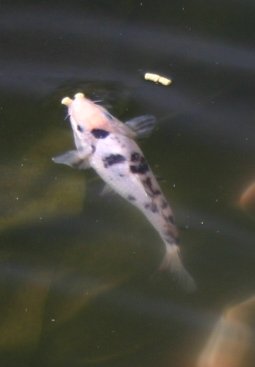
The time of year that the water falls consistently below 50 degrees will differ depending on your area, the volume of your pond and daytime temperatures. You can get a 3 dollar water thermometer at your local pet store and it will be one of the best if not cheapest investments you make in your pond. Monitor the temperatures daily in the fall so that you can have a better understanding of the water's temperature.
Because you are removing all surface plants, your fish will be vulnerable to attacks from predators such as birds and raccoons. Be aware of this and provide hiding spaces for your fish at the bottom of the pond. You can prop up the potted plants to create nooks for fish to hide. You can also find koi castles or the like from pet stores to provide ample room for safety.
Pond Mechanisms
You have to decide what you are going to do with the mechanics in your pond. This is a personal decision that you need to make well informed. In more moderate zones, such as 7 through 10, you probably don't have to take out your pump for winter but different people do different things. If you have a waterfall, you can leave it on all winter as some people do to keep the water in motion and to keep an opening in the ice. No matter what decision you make, you have to check your pond consistently through the winter. Watch especially close for ice damming. Ice damming occurs when ice forms and diverts the water out of your pond. It is not unheard of for people to come out and find all of their pond water in a frozen sheet outside of the pond with their pond completely empty behind a sheet of ice. This would be a tragic way to learn the hard way, so be educated and vigilant about watching the pond.
With that said, if you decide to turn off your pump for the winter, you need to get it winterized as well. If there is any chance the pump could freeze within the pond, you should probably pull it out and store it in a safe place such as a garage. Older pumps may need to be stored in water for the winter so that the plastic does not get brittle. Newer pumps are made so that they can be dried and stored for the winter. Read the literature that comes with your pump to find the best method.
If you decide to turn off your pump and waterfall during the winter, you'll need to find a way to keep a hole in the ice if you have fish. The hole will allow for the gas exchange necessary for your fish to survive. The hole does not need to be large, but it must remain opened through the ice.
You can keep this hole open in a variety of ways:
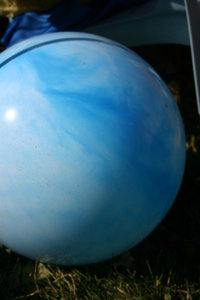
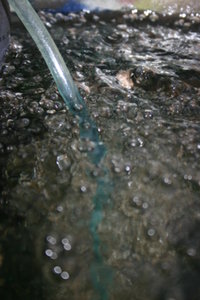 Children's bouncy ball-acts as a greenhouseAir pump and airstone keeps water moving
Children's bouncy ball-acts as a greenhouseAir pump and airstone keeps water moving
If any of these methods fail and a solid sheet of ice forms, don't panic. Fish have been known to survive just fine underneath a 6 inch sheet of ice for months on end, though it is probably not advisable to take a chance. For emergencies such as a failed de-icer, you can pour boiling water over the surface until a hold forms or you can boil water in a tea kettle and place it on the surface until it melts a hole. Whatever you do though, do NOT break a hole in the ice with a hammer or otherwise. This will disrupt your fish and cause unneeded shock.
Once you have these few steps completed, your pond will be ready for winter. Always check on your pond every couple of days through winter so that you are aware of what is going on. Don't stress out too much during the winter though, because your pond plants and fish will survive more than we give them credit for. Instead, use the colder months to plan what you'll do bigger and better in the pond next year!
All images are copyrighted to Susanne Talbert
(Editor's Note: This article was originally published on November 6, 2008. Your comments are welcome, but please be aware that authors of previously published articles may not be able to promptly respond to new questions or comments.)
Copyright © www.100flowers.win Botanic Garden All Rights Reserved